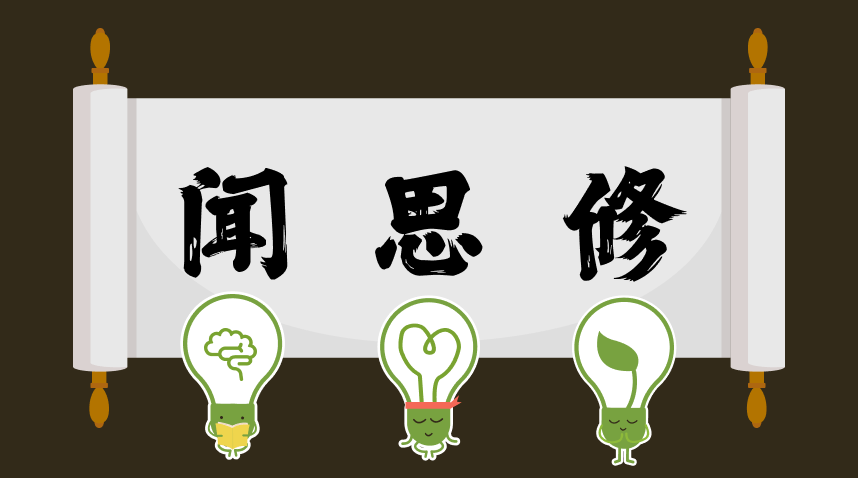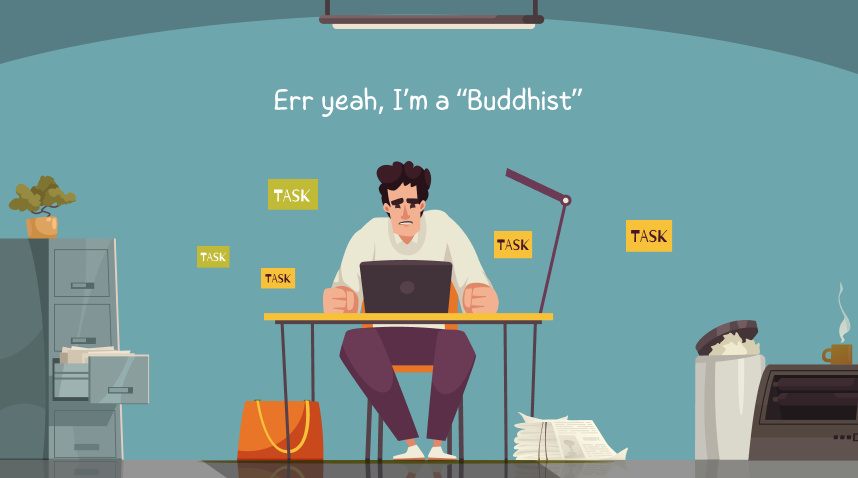TLDR: Life felt like “Groundhog Day” until Buddhism showed a way out. Now, every moment is an opportunity for growth and awakening since I stopped being a mundane Buddhist.
Enough is enough. It all started when I was working at F&N Coca-Cola. Unlike many, I was fortunate to be offered a full-time contract position as a designer. My days began at 5:30 AM, catching the company bus, and heading to Tuas where I’d get Malaysian telecom signals—it felt like living in a scene straight out of “Groundhog Day.”
For those who might not know, “Groundhog Day” is a movie about a man reliving the same day over and over again. That’s exactly how I felt—physically paralysed by life, trapped in a never-ending cycle. The saddest part? I had grown to accept it with an unsettling sense of normalcy.
How does this relate to my Buddhist path?
Well, it all began when I stepped into the world of Dharma by volunteering as a temple guide at Bright Hill Temple. Although I had read several Dharma books and was fascinated by the teachings, I didn’t fully engage with Buddhism until I started exploring the diverse Buddhist art forms and learning about the stories behind each Buddha and Bodhisattva.
My initial understanding of Buddhism might have been superficial, driven primarily by a strong interest in Buddhist art and architecture. But that passion led me to make a life-changing decision: I quit my job, became a freelance designer, and embarked on a backpacking journey to Thailand, the first country outside of Malaysia (which is practically a rite of passage for Singaporeans to visit).
There, I immersed myself in the breathtaking beauty of Buddha images and temples, deepening my connection to both the art and the essence of Buddhism as I travelled to Sri Lanka, Cambodia, Laos, Vietnam, India and many more.
Silly me, I once thought that knowing all the history of Buddhism and the different schools of thought was all I needed. But I soon realized that this knowledge barely scratched the surface of Buddhism’s true essence—understanding what awakening means and how to genuinely navigate life.
I needed to go deeper.

I needed to understand the core principles: the Three Characteristics of Buddhism, the Four Immeasurables, and the Five Precepts. I needed to learn how to integrate them into my daily life to gain true insight.
I couldn’t settle for being a mundane Buddhist; I had a goal, and that goal was Nirvana (awakening).
In pursuing this deeper understanding, I found my purpose.
Making a positive difference in the lives of others
Twelve years ago, a Buddhist friend invited me to Dharamshala, India, to attend teachings by the 14th Dalai Lama. That first experience was transformative, and for the next decade, I attended his teachings regularly, on and off. I even became part of the volunteer team, helping out with tasks like washing toilets, arranging flowers, and handling registration.
What truly fueled my Buddhist practice was the unparalleled compassion I received from the Dalai Lama. He exemplifies true compassion and how deeply unconditional it can be.
It strengthened my belief in the importance of compassion for others and deepened my understanding of our interconnectedness with the world. It has become my practice.
Discover your intention and outline your own path.
When you decide to follow the path of Buddhism, you’ll quickly notice how different you become from the majority. Some people might think you’re too unrealistic, others might see you as overly superstitious, and some might even suspect you’re in a cult. But I’ve found that actions speak louder than words.
Ever since I committed to integrating Dharma practice into my daily life, many of my friends have noticed changes in me—my demeanour is less “diva-like,” my temper has mellowed, and I’m not as defensive as I used to be.
Unravel the reasons why Buddhist teachings may benefit you.
It dawned on me that maybe my practices were making a real impact. I’ve since taken on more leadership roles within Buddhist communities and continued to lead temple tours to debunk misconceptions about Buddhism, all while maintaining my livelihood as a freelance designer.
Quitting your job and embarking on a “holy mission” as a Buddhist isn’t an easy path. There will be many profound moments that challenge you, perfectly illustrating the Buddhist teaching on impermanence. I won’t presume to tell you what you should do with your life—how could I, when I don’t truly know you? Many “true callings” await you.
And honestly, you won’t need to search for passion in Buddhism because its truth is so compelling; it’s like a big slap on your existence, one that awakens you deeply.
What I hope to share with you is that there’s always a way to balance and practice Buddhism, following the Middle Path that the Buddha taught us. You can’t go too extreme in self-indulgence nor can you go too extreme in self-mortification. This means everything you see, do, and experience can be an opportunity to practice Dharma. Balance is key, and it’s about integrating those teachings into everyday life without going to extremes.
You can still drive a BMW and find peace even when it breaks down. You can enjoy a five-star Michelin meal without getting attached to the taste or letting it inflate your ego or status. You can watch a movie, be entertained, and still understand that it’s all part of the transient nature of life.
Integrating these steps into your daily life enables you to balance enjoying worldly pleasures while remaining unattached, thus walking the Middle Path.
闻思修 (Hear, Contemplate, and Cultivate)

One valuable lesson I’ve learned from the Mahayana master, Ven Hsing Yun (one of my inspirational teachers) is the method of Dharma learning called 闻思修 (Wén Sī Xiū)
Without embracing 闻思修 (Wén Sī Xiū), it’s akin to watching a heart-wrenching documentary about underprivileged children in the slums. You might find yourself shedding tears of empathy, only to turn off the TV, go to bed, and forget about it.
[闻 (Wén)] refers to listening to the Buddha’s Dharma. This includes studying Buddhist scriptures and attending Dharma lectures, through which you gain “hearing wisdom.”
The second step is [思 (Sī)], which means to contemplate what you’ve heard. This involves deep thinking, reflecting, analysing, and understanding the teachings, resulting in “thinking wisdom.”
Lastly, [修 (Xiū)] involves cultivating the wisdom you’ve gained from contemplation. Through diligent practice, you obtain “cultivation wisdom.” This wisdom helps you eliminate suffering and progress on the path to awakening.
Importantly, there’s no specific order in which you should start your practice. Always dedicate your merits and continuous learning of Dharma for yourself and all sentient beings. It may seem like you don’t have much merit to begin with, but don’t underestimate the power of dedicating them. No dedication of merits is too small.
There are numerous ways to understand the dedication of merits. You can feel incredibly grateful and fortunate for being able to hear or understand the Dharma, allowing joy to arise within you. Share this joy with those who need the Dharma the most. You might also send your dedication of merits through acts of loving-kindness and compassion, wishing that no one gets harmed. Additionally, rejoice in the efforts of others following the path of the Buddha.
Remember, time is always available for you to practice.
Taking time out for meditation, surrounding yourself with Dharma books, and reading articles from Handful of Leaves can be incredibly helpful. Having a Buddhist practice community to keep you grounded is also essential.
And remember, be patient with yourself if you don’t see immediate results. According to the Jataka tales, the Buddha spoke of his 547 previous lifetimes, giving us perspective on the long journey toward enlightenment. We might not know exactly which lifetime it will happen in, but every step we take brings us closer.
This is how you can transform your mundane life into a purposeful one, unlike a mundane Buddhist.
Wise steps:
- While Buddhist practices can sometimes feel out of place in our modern society, finding ways to weave them into your everyday life is essential. Create a personal practice that resonates with you and aligns with the “real world,” making your spiritual journey part of your daily routine.
- Follow the method of “Hear, Contemplate, and Cultivate” to deepen your understanding and embodiment of the teachings. Listen to the Dharma, reflect on its meanings, and put it into practice to truly integrate the wisdom into your life.
- Dedication of merits is more than just a simple ritual; it’s a powerful practice that generates conviction and supports your ongoing journey in Buddhist learning. By dedicating your merits, you not only cultivate compassion and loving-kindness but also sustain your commitment to enlightenment and benefit all sentient beings.


